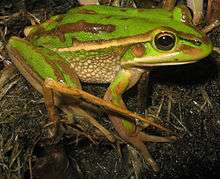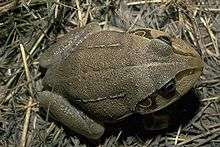Ranoidea (genus)
| Ranoidea | |
|---|---|
 | |
| Ranoidea aurea, the type species | |
| Scientific classification | |
| Kingdom: | Animalia |
| Phylum: | Chordata |
| Class: | Amphibia |
| Order: | Anura |
| Family: | Hylidae |
| Subfamily: | Pelodryadinae |
| Genus: | Ranoidea Tschudi, 1838 |
| Type species | |
| Ranoidea jacksoniensis Tschudi, 1838 | |
| Synonyms[1] | |
| |
Ranoidea is a genus of frogs in the subfamily Pelodryadinae. They are found in Australia, New Guinea, and two nearby groups of islands: Maluku Islands (=Moluccas) and Louisiade Archipelago.[1] The circumscription of this taxon is still controversial.

Taxonomy
Species in this genus were until recently placed in the then-paraphyletic genus Litoria (and mostly still are in Wikipedia); many of them had been placed in even larger Hyla before. However, in 2016 Duellman and colleagues split Litoria into several genera.[1][2] The species now in Ranoidea were placed in the genus Dryopsophus. However, the oldest available name for these species is Ranoidea.[1] These changes are not yet widely recognized, and the AmphibiaWeb continues to recognize Litoria in the older, broad sense.[3] The AmphibiaWeb also recognizes Cyclorana,[3] a position that, without additional amendments, renders Ranoidea paraphyletic; it may be treated as a subgenus.[1]
Some controversy also surrounds whether the subfamily Pelodryadinae is part of the family Pelodryadidae, as suggested by Duellman and colleagues[2] and recognized in the Amphibian Species of the World,[1] or part of the family Hylidae, as recognized in the AmphibiaWeb.[3]
Description and ecology
The pupil is horizontally elliptical, and the palpebral membrane is unpigmented. Many species have tadpoles that develop in mountain streams and have enlarged ventral mouths.[2] However, "Cyclorana" are adapted to standing and often temporary bodies of water.[4]
Species
There are 75 species in this genus:[1]
- "Ranoidea papua" (Van Kampen, 1909)
- Ranoidea alboguttata (Günther, 1867)
- Ranoidea andiirrmalin (McDonald, 1997)
- Ranoidea aruensis (Horst, 1883)
- Ranoidea auae (Menzies and Tyler, 2004)
- Ranoidea aurea (Lesson, 1829)
- Ranoidea australis (Gray, 1842)
- Ranoidea barringtonensis (Copland, 1957)
- Ranoidea becki (Loveridge, 1945)
- Ranoidea bella (McDonald, Rowley, Richards, and Frankham, 2016)
- Ranoidea booroolongensis (Moore, 1961)
- Ranoidea brevipes (Peters, 1871)
- Ranoidea brongersmai (Loveridge, 1945)
- Ranoidea bulmeri (Tyler, 1968)
- Ranoidea caerulea (White, 1790)
- Ranoidea callista (Kraus, 2013)
- Ranoidea cavernicola (Tyler and Davies, 1979)
- Ranoidea chloris (Boulenger, 1892)
- Ranoidea citropa (Péron, 1807)
- Ranoidea cryptotis (Tyler and Martin, 1977)
- Ranoidea cultripes (Parker, 1940)
- Ranoidea cyclorhynchus (Boulenger, 1882)
- Ranoidea dahlii (Boulenger, 1896)
- Ranoidea daviesae (Mahony, Knowles, Foster, and Donnellan, 2001)
- Ranoidea dayi (Günther, 1897)
- Ranoidea dorsivena (Tyler, 1968)
- Ranoidea elkeae (Günther and Richards, 2000)
- Ranoidea eschata (Kraus and Allison, 2009)
- Ranoidea eucnemis (Lönnberg, 1900)
- Ranoidea exopthalmia (Tyler, Davies, and Aplin, 1986)
- Ranoidea fuscula (Oliver and Richards, 2007)
- Ranoidea genimaculata (Horst, 1883)
- Ranoidea gilleni (Spencer, 1896)
- Ranoidea gracilenta (Peters, 1869)
- Ranoidea graminea (Boulenger, 1905)
- Ranoidea impura (Peters and Doria, 1878)
- Ranoidea jungguy (Donnellan and Mahony, 2004)
- Ranoidea kroombitensis (Hoskin, Hines, Meyer, Clarke, and Cunningham, 2013)
- Ranoidea kumae (Menzies and Tyler, 2004)
- Ranoidea lesueurii (Duméril and Bibron, 1841)
- Ranoidea longipes (Tyler and Martin, 1977)
- Ranoidea lorica (Davies and McDonald, 1979)
- Ranoidea macki (Richards, 2001)
- Ranoidea maculosa (Tyler and Martin, 1977)
- Ranoidea maini (Tyler and Martin, 1977)
- Ranoidea manya (Van Beurden and McDonald, 1980)
- Ranoidea moorei (Copland, 1957)
- Ranoidea myola (Hoskin, 2007)
- Ranoidea nannotis (Andersson, 1916)
- Ranoidea napaea (Tyler, 1968)
- Ranoidea novaehollandiae (Steindachner, 1867)
- Ranoidea nudidigita (Copland, 1963)
- Ranoidea nyakalensis (Liem, 1974)
- Ranoidea occidentalis (Anstis, Price, Roberts, Catalano, Hines, Doughty, and Donnellan, 2016)
- Ranoidea pearsoniana (Copland, 1961)
- Ranoidea phyllochroa (Günther, 1863)
- Ranoidea piperata (Tyler and Davies, 1985)
- Ranoidea platycephala (Günther, 1873)
- Ranoidea pratti (Boulenger, 1911)
- Ranoidea raniformis (Keferstein, 1867)
- Ranoidea rara (Günther and Richards, 2005)
- Ranoidea rheocola (Liem, 1974)
- Ranoidea rivicola (Günther and Richards, 2005)
- Ranoidea robinsonae (Oliver, Stuart-Fox, and Richards, 2008)
- Ranoidea rueppelli (Boettger, 1895)
- Ranoidea sauroni (Richards and Oliver, 2006)
- Ranoidea serrata (Andersson, 1916)
- Ranoidea spenceri (Dubois, 1984)
- Ranoidea spinifera (Tyler, 1968)
- Ranoidea splendida (Tyler, Davies, and Martin, 1977)
- Ranoidea subglandulosa (Tyler and Anstis, 1983)
- Ranoidea vagitus (Tyler, Davies, and Martin, 1981)
- Ranoidea verrucosa (Tyler and Martin, 1977)
- Ranoidea wilcoxii (Günther, 1864)
- Ranoidea xanthomera (Davies, McDonald, and Adams, 1986)
References
- 1 2 3 4 5 6 7 Frost, Darrel R. (2018). "Ranoidea Tschudi, 1838". Amphibian Species of the World: an Online Reference. Version 6.0. American Museum of Natural History. Retrieved 18 June 2018.
- 1 2 3 4 Duellman, William E.; Marion, Angela B. & Hedges, S. Blair (19 April 2016). "Phylogenetics, classification, and biogeography of the treefrogs (Amphibia: Anura: Arboranae)". Zootaxa. 4104 (1): 1–109. doi:10.11646/zootaxa.4104.1.1.
- 1 2 3 "Hylidae". AmphibiaWeb. University of California, Berkeley. 2018. Retrieved 18 June 2018.
- ↑ Van Buskirk, J. (2009). "Getting in shape: adaptation and phylogenetic inertia in morphology of Australian anuran larvae". Journal of Evolutionary Biology. 22 (6): 1326–1337. doi:10.1111/j.1420-9101.2009.01750.x.